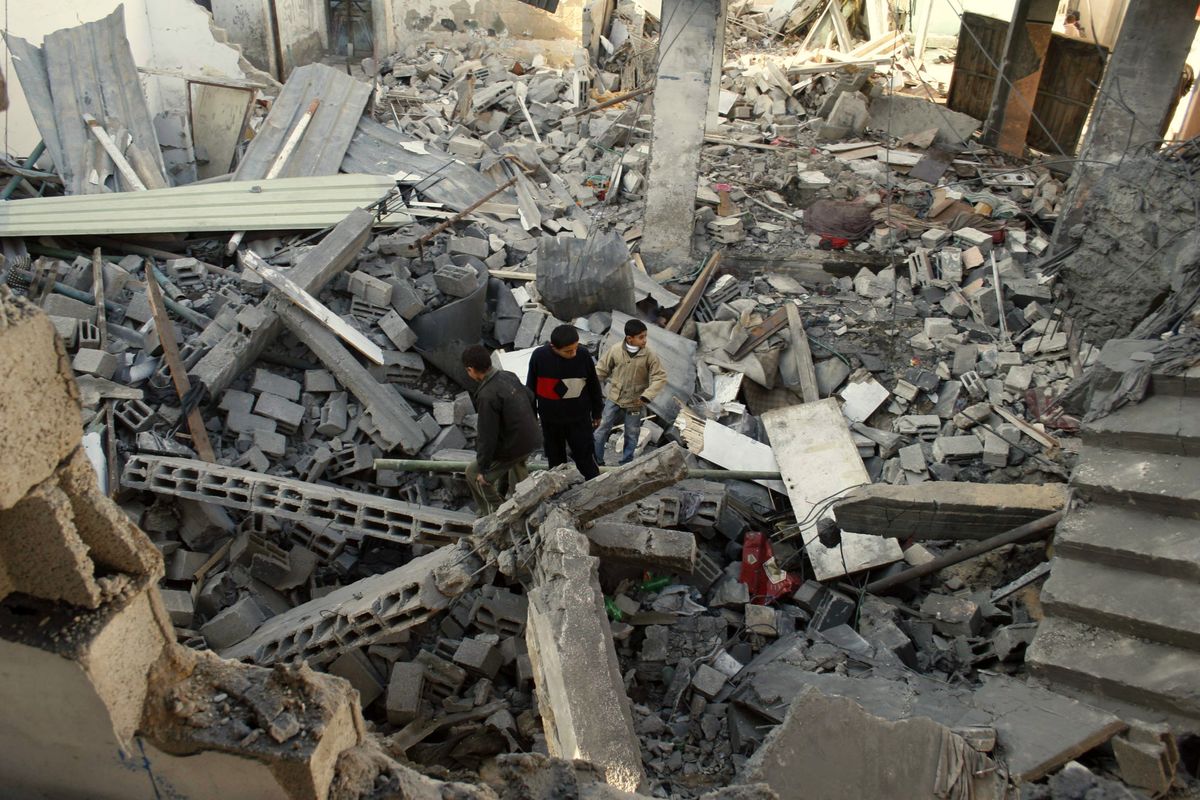Egypt, France propose truce
Israeli shelling kills 30 at Gaza school

GAZA CITY, Gaza – France and Egypt announced an initiative to stop the fighting in Gaza late Tuesday, hours after Israeli mortar shells exploded near a U.N. school sheltering hundreds of people displaced by the onslaught on Hamas militants. At least 30 Palestinians died, staining streets with blood.
The Egyptian and French presidents didn’t release details of their proposal, saying only that it involved an immediate cease-fire to permit humanitarian aid into Gaza and talks to settle the differences between Israel and the Islamic militants of Hamas who rule the small coastal territory.
They said they were awaiting a response from Israel. Israeli officials in Jerusalem declined immediate comment on the announcement, which came amid diplomatic efforts by the U.S. and other nations to resolve a conflict that has seen 600 people killed in 11 days.
Secretary of State Condoleezza Rice welcomed the initiative, but cautioned that no agreement would succeed unless it halted Hamas rocket attacks on Israel and arms smuggling into Gaza.
Earlier in the day, President-elect Barack Obama broke his silence on the crisis, saying that “the loss of civilian life in Gaza and in Israel is a source of deep concern for me.” He declined to go further, reiterating his stance that the U.S. has only one president at a time.
Israel’s military said its shelling at the school – the deadliest single episode since Israeli ground forces invaded Gaza on Saturday after a week of air bombardment – was a response to mortar fire from within the school and said Hamas militants were using civilians as cover.
Two residents of the area who spoke with the Associated Press by telephone said they saw a small group of militants firing mortar rounds from a street near the school, where 350 people had gathered to get away from the shelling.
Majed Hamdan, an AP photographer, rushed to the scene shortly after the attacks. At the hospital, he said, many children were among the dead.
“I saw women and men – parents – slapping their faces in grief, screaming, some of them collapsed to the floor. They knew their children were dead,” he said. “In the morgue, most of the killed appeared to be children. In the hospital, there wasn’t enough space for the wounded.”
He said there appeared to be marks on the pavement of five separate explosions in area of the school.
An Israeli defense official said it appeared the military used 120-mm shells, among the largest mortar rounds.
U.N. officials demanded an investigation of the shelling. The carnage, which included 55 wounded, added to a surging civilian toll and drew mounting international pressure for Israel to end the offensive against Hamas.
At a news conference in Sharm-el-Sheik, Egypt, Egyptian President Hosni Mubarak said the truce proposal offered by him and French President Sarkozy envisioned an immediate end to combat, so humanitarian supplies can safely enter Gaza.
Mubarak said the plan also calls for an urgent meeting between Israel and the Palestinians to discuss ways to resolve the conflict and provide necessary guarantees to ensure fighting doesn’t erupt again.
There was no indication of the plan’s chances. Sarkozy said at the news conference that he saw it as a “small hope” for ending the Gaza violence.
Sarkozy said he had spoken to Israeli Prime Minister Ehud Olmert to inform him of the initiative and was awaiting a response.
He said Mubarak invited Israel “to come discuss the question of border security … (and) that could be in the hours ahead.”
In Jerusalem, Olmert’s spokesman, Mark Regev, told the AP: “We are holding off comments on that for the time being.”
At U.N. headquarters, Palestinian President Mahmoud Abbas welcomed the proposal. “I express my support for the plan set in motion today by President Mubarak and President Sarkozy,” said Abbas.
Israeli officials have said any cease-fire agreement must prevent further rocket attacks by Gaza militants and put in place measures to prevent the smuggling of missile and other weapons into the small Palestinian territory.
Rice told the Security Council meeting that the U.S. understood the growing desire for a cease-fire. “In this regard, we are pleased by, and wish to commend, the statement of the president of Egypt and to follow up on that initiative,” she said.
But Rice added that any solution must address Israel’s security.
“There must be a solution this time that does not allow Hamas to use Gaza as a launching pad against Israeli cities. It has to be a solution that does not allow the rearmament of Hamas, and it must be a solution that finds a way to open (border) crossings so that Palestinians in Gaza can have a normal life,” she said.
In the wake of the criticism over civilian casualties, Israel agreed to set up a “humanitarian corridor” to ship vital supplies into the Gaza Strip. Under the plan, put forward by the Israeli Defense Ministry, Israel would suspend attacks in certain areas to allow people to get supplies.
At U.N. headquarters, Secretary-General Ban Ki-moon called the Israeli bombardment of U.N. facilities in Gaza “totally unacceptable.” Israel’s shells have fallen around three schools, including the girls school hit Tuesday, and a health center for Palestinian refugees.
Some 15,000 Palestinians have packed the U.N.’s 23 Gaza schools because their homes were destroyed or to flee the violence. The U.N. provided the Israeli military with GPS coordinates for all of them.
The three mortar shells that crashed down on the perimeter of the U.N. school struck at mid-afternoon, when many people in the densely populated camp were outside getting some fresh air, thinking an area around a school was safe.
An Israeli military statement said it received intelligence that the dead at the girls school included Hamas operatives, among them members of a rocket-launching squad.